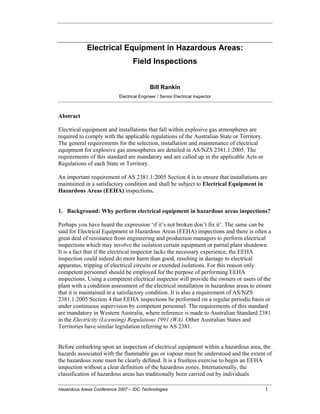The 8-Minute Rule for Roar Solutions
Wiki Article
Roar Solutions Fundamentals Explained
Table of Contents8 Simple Techniques For Roar SolutionsRoar Solutions Fundamentals ExplainedThe Ultimate Guide To Roar Solutions
In such an atmosphere a fire or surge is feasible when three fundamental problems are fulfilled. This is typically referred to as the "unsafe location" or "combustion" triangular. In order to shield setups from a potential surge a method of evaluating and categorizing a possibly dangerous location is required. The function of this is to guarantee the correct option and setup of tools to inevitably prevent an explosion and to make certain safety of life.
(https://roar-solutions.webflow.io/)
No devices ought to be mounted where the surface area temperature of the tools is above the ignition temperature of the provided danger. Below are some common dirt hazardous and their minimum ignition temperature level. Coal Dirt 380C 225C Polythene 420C (thaws) Methyl Cellulose 420C 320C Starch 460C 435C Flour 490C 340C Sugar 490C 460C Grain Dirt 510C 300C Phenolic Material 530C > 450C Aluminium 590C > 450C PVC 700C > 450C Residue 810C 570C The likelihood of the threat existing in a focus high enough to trigger an ignition will vary from area to place.
In order to classify this danger an installment is split right into locations of risk relying on the quantity of time the dangerous exists. These locations are referred to as Zones. For gases and vapours and dusts and fibres there are 3 zones. Zone 0 Zone 20 A harmful atmosphere is very most likely to be present and might be existing for lengthy durations of time (> 1000 hours annually) or perhaps continuously Zone 1 Area 21 An unsafe atmosphere is feasible however unlikely to be existing for long durations of time (> 10 450 C [842 F] A classification of T6 suggests the minimal ignition temperature is > 85 C [185 F] Unsafe location electric devices possibly made for use in greater ambient temperatures. This would certainly suggested on the ranking plate e.g. EExe II C T3 Ta + 60C( This implies at 60C ambient T3 will not be gone beyond) T1 T1, T2, T3, T4, T5, T6 T2 T2, T3, T4, T5, T6 T3 T3, T4, T5, T6 T4 T4, T5, T6 T5 T5, T6 T6 T6 A T Class score of T1 indicates the maximum surface temperature produced by the instrument at 40 C is 450 C. Thinking the connected T Course and Temperature score for the devices are proper for the area, you can constantly make use of an instrument with an extra rigid Division ranking than needed for the location. There isn't a clear solution to this concern unfortunately. It actually does depend on the kind of tools and what repair services need to be accomplished. Equipment with particular examination procedures that can't be performed in the area in order to achieve/maintain 3rd party rating. Need to return to the factory if it is prior to the equipment's solution. Area Fixing By Authorised Personnel: internet Complex testing may not be required however particular procedures may need to be adhered to in order for the tools to preserve its third celebration rating. Authorised employees have to be utilized to carry out the job appropriately Repair service need to be a like for like replacement. New component have to be thought about as a straight replacement needing no unique screening of the tools after the repair work is full. Each tool with a dangerous rating need to be assessed separately. These are outlined at a high level listed below, yet for more detailed info, please refer directly to the guidelines.
Indicators on Roar Solutions You Need To Know
The equipment register is an extensive database of tools documents that consists of a minimum set of fields to determine each item's place, technical parameters, Ex classification, age, and environmental information. The ratio of Comprehensive to Close assessments will be established by the Equipment Threat, which is examined based on ignition risk (the likelihood of a source of ignition versus the probability of a flammable ambience )and the harmful area category( Zone 0Area 1, or 2). Applying a durable Risk-Based Examination( RBI )method is crucial for making sure conformity and safety and security in handling Electric Tools in Hazardous Locations( EEHA).
Roar Solutions Fundamentals Explained

In terms of eruptive risk, an unsafe location is an environment in which an explosive atmosphere exists (or may be anticipated to be present) in amounts that need unique precautions for the building, installation and usage of equipment. hazardous area electrical course. In this post we discover the obstacles faced in the office, the risk control procedures, and the called for expertises to function safely
These substances can, in particular conditions, develop eruptive environments and these can have major and heartbreaking effects. Most of us are acquainted with the fire triangle remove any one of the 3 components and the fire can not occur, however what does this mean in the context of unsafe areas?
In a lot of circumstances, we can do little regarding the levels of oxygen airborne, yet we can have substantial influence on sources of ignition, for instance electric devices. Unsafe areas are recorded on the hazardous location category drawing and are recognized on-site by the triangular "EX LOVER" indication. Here, amongst various other essential details, zones are divided into three types depending on the hazard, the probability and period that an eruptive atmosphere will certainly exist; Zone 0 or 20 is deemed one of the most dangerous and Area 2 or 22 is deemed the least.
Report this wiki page